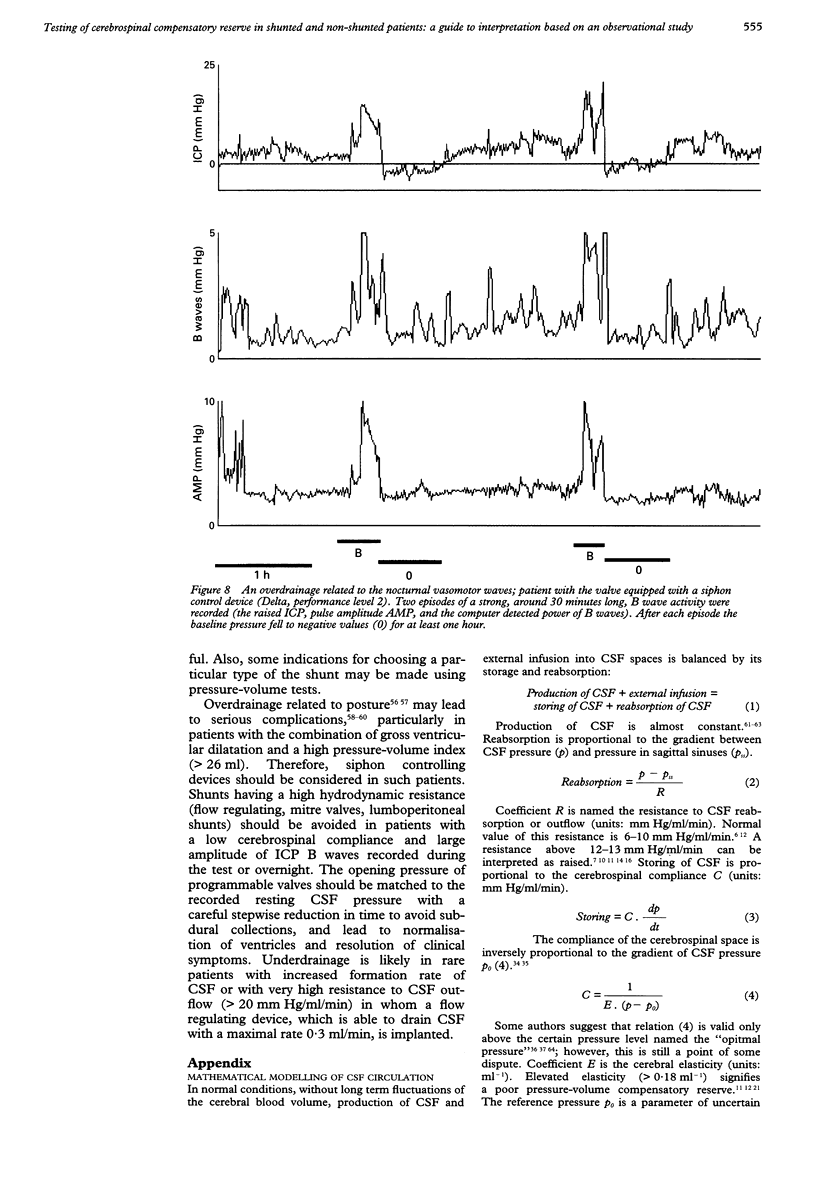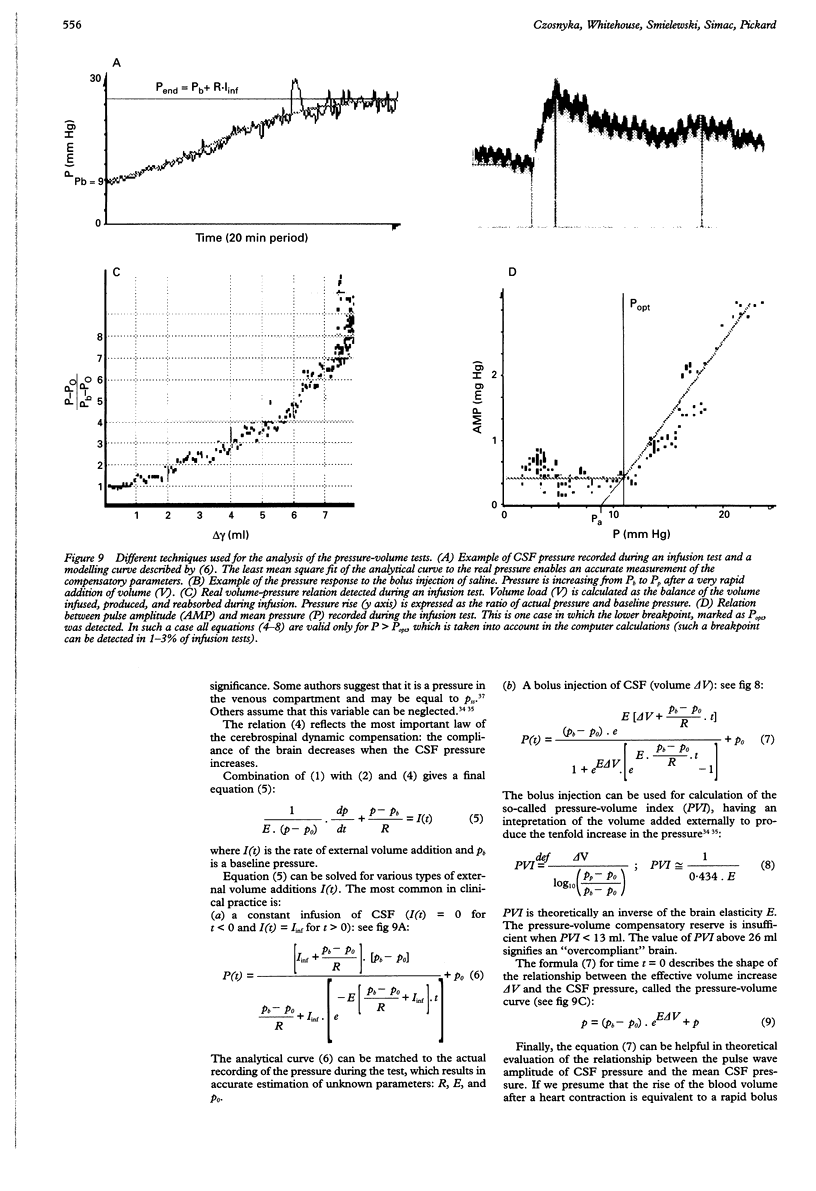Abstract
OBJECTIVE--To design a computerised infusion test to compensate for the disadvantages of Katzman's lumbar infusion method: inadequate accuracy of estimation of the resistance to cerebrospinal fluid outflow and poor predictive value in normal pressure hydrocephalus. METHODS--Accuracy was improved by intracranial pressure signal processing and model analysis for measurement of cerebrospinal compensatory variable. These include the CSF outflow resistance, brain compliance, pressure-volume index, estimated sagittal sinus pressure, CSF formation rate, and other variables. Infusion may be made into the lumbar space, ventricles, or, when assessing shunt function in vivo, the shunt chamber. RESULTS AND CONCLUSIONS--The computerised test has been used for five years in a multicentre study in 350 hydrocephalic patients of various ages, aetiologies, and states of cerebrospinal compensation. The principles of using the test to characterise different types of CSF circulatory disorders in patients presenting with ventricular dilatation, including brain atrophy and normal and high pressure hydrocephalus, are presented and illustrated. Previous studies showed a positive correlation between cerebrospinal compensatory variables and the results of shunting, but such a prediction remains difficult in idiopathic normal pressure hydrocephalus, particularly in elderly patients. The technique is helpful in the assessment of shunt malfunction, including posture-related overdrainage, over-drainage related to the nocturnal B wave activity, and proximal or distal shunt obstruction. The appendix presents an introduction of the mathematical modelling of CSF pressure volume-compensation included in computerised infusion test software.
Full text
PDF









Images in this article
Selected References
These references are in PubMed. This may not be the complete list of references from this article.
- Albeck M. J., Børgesen S. E., Gjerris F., Schmidt J. F., Sørensen P. S. Intracranial pressure and cerebrospinal fluid outflow conductance in healthy subjects. J Neurosurg. 1991 Apr;74(4):597–600. doi: 10.3171/jns.1991.74.4.0597. [DOI] [PubMed] [Google Scholar]
- Aschoff A., Kremer P., Benesch C., Fruh K., Klank A., Kunze S. Overdrainage and shunt technology. A critical comparison of programmable, hydrostatic and variable-resistance valves and flow-reducing devices. Childs Nerv Syst. 1995 Apr;11(4):193–202. doi: 10.1007/BF00277653. [DOI] [PubMed] [Google Scholar]
- Bolander H. G. A new method for long-term lumbar pressure monitoring with a fiber optic catheter. Acta Neurochir (Wien) 1990;105(3-4):135–139. doi: 10.1007/BF01669997. [DOI] [PubMed] [Google Scholar]
- Bradley W. G., Jr, Whittemore A. R., Kortman K. E., Watanabe A. S., Homyak M., Teresi L. M., Davis S. J. Marked cerebrospinal fluid void: indicator of successful shunt in patients with suspected normal-pressure hydrocephalus. Radiology. 1991 Feb;178(2):459–466. doi: 10.1148/radiology.178.2.1987609. [DOI] [PubMed] [Google Scholar]
- Børgesen S. E., Albeck M. J., Gjerris F., Czosnyka M., Laniewski P. Computerized infusion test compared to steady pressure constant infusion test in measurement of resistance to CSF outflow. Acta Neurochir (Wien) 1992;119(1-4):12–16. doi: 10.1007/BF01541775. [DOI] [PubMed] [Google Scholar]
- Børgesen S. E., Gjerris F., Srensen S. C. The resistance to cerebrospinal fluid absorption in humans. A method of evaluation by lumbo-ventricular perfusion, with particular reference to normal pressure hydrocephalus. Acta Neurol Scand. 1978 Jan;57(1):88–96. doi: 10.1111/j.1600-0404.1978.tb04500.x. [DOI] [PubMed] [Google Scholar]
- Børgesen S. E., Gjerris F. The predictive value of conductance to outflow of CSF in normal pressure hydrocephalus. Brain. 1982 Mar;105(Pt 1):65–86. doi: 10.1093/brain/105.1.65. [DOI] [PubMed] [Google Scholar]
- Cardoso E. R., Piatek D., Del Bigio M. R., Stambrook M., Sutherland J. B. Quantification of abnormal intracranial pressure waves and isotope cisternography for diagnosis of occult communicating hydrocephalus. Surg Neurol. 1989 Jan;31(1):20–27. doi: 10.1016/0090-3019(89)90214-0. [DOI] [PubMed] [Google Scholar]
- Chopp M., Portnoy H. D. Systems analysis of intracranial pressure. Comparison with volume-pressure test and CSF-pulse amplitude analysis. J Neurosurg. 1980 Oct;53(4):516–527. doi: 10.3171/jns.1980.53.4.0516. [DOI] [PubMed] [Google Scholar]
- Costabile G., Probst C. Intrathecal infusion test and decrease in shunt revisions and infections. Neurochirurgia (Stuttg) 1988 Jul;31(4):134–135. doi: 10.1055/s-2008-1053919. [DOI] [PubMed] [Google Scholar]
- Czosnyka M., Batorski L., Laniewski P., Maksymowicz W., Koszewski W., Zaworski W. A computer system for the identification of the cerebrospinal compensatory model. Acta Neurochir (Wien) 1990;105(3-4):112–116. doi: 10.1007/BF01669992. [DOI] [PubMed] [Google Scholar]
- Czosnyka M., Batorski L., Roszkowski M., Tomaszewski J., Wocjan J., Walencik A., Zabolotny W. Cerebrospinal compensation in hydrocephalic children. Childs Nerv Syst. 1993 Feb;9(1):17–22. doi: 10.1007/BF00301929. [DOI] [PubMed] [Google Scholar]
- Czosnyka M., Maksymowicz W., Batorski L., Koszewski W., Czosnyka Z. Comparison between classic-differential and automatic shunt functioning on the basis of infusion tests. Acta Neurochir (Wien) 1990;106(1-2):1–8. doi: 10.1007/BF01809325. [DOI] [PubMed] [Google Scholar]
- Czosnyka M., Pickard J., Whitehouse H., Piechnik S. The hyperaemic response to a transient reduction in cerebral perfusion pressure. A modelling study. Acta Neurochir (Wien) 1992;115(3-4):90–97. doi: 10.1007/BF01406364. [DOI] [PubMed] [Google Scholar]
- Ekstedt J. CSF hydrodynamic studies in man. 1. Method of constant pressure CSF infusion. J Neurol Neurosurg Psychiatry. 1977 Feb;40(2):105–119. doi: 10.1136/jnnp.40.2.105. [DOI] [PMC free article] [PubMed] [Google Scholar]
- Epstein F., Lapras C., Wisoff J. H. 'Slit-ventricle syndrome': etiology and treatment. Pediatr Neurosci. 1988;14(1):5–10. [PubMed] [Google Scholar]
- Foltz E. L., Blanks J. P. Symptomatic low intracranial pressure in shunted hydrocephalus. J Neurosurg. 1988 Mar;68(3):401–408. doi: 10.3171/jns.1988.68.3.0401. [DOI] [PubMed] [Google Scholar]
- Foltz E. L., Blanks J. P., Yonemura K. CSF pulsatility in hydrocephalus: respiratory effect on pulse wave slope as an indicator of intracranial compliance. Neurol Res. 1990 Jun;12(2):67–74. doi: 10.1080/01616412.1990.11739918. [DOI] [PubMed] [Google Scholar]
- Fridén H., Ekstedt J. Instrumentation for cerebrospinal fluid hydrodynamic studies in man. Med Biol Eng Comput. 1982 Mar;20(2):167–180. doi: 10.1007/BF02441352. [DOI] [PubMed] [Google Scholar]
- Gjerris F., Børgesen S. E., Sørensen P. S., Boesen F., Schmidt K., Harmsen A., Lester J. Resistance to cerebrospinal fluid outflow and intracranial pressure in patients with hydrocephalus after subarachnoid haemorrhage. Acta Neurochir (Wien) 1987;88(3-4):79–86. doi: 10.1007/BF01404142. [DOI] [PubMed] [Google Scholar]
- Hara K., Nakatani S., Ozaki K., Ikeda T., Mogami H. Detection of the B waves in the oscillation of intracranial pressure by fast Fourier transform. Med Inform (Lond) 1990 Apr-Jun;15(2):125–131. doi: 10.3109/14639239008997664. [DOI] [PubMed] [Google Scholar]
- Hara M., Kadowaki C., Konishi Y., Ogashiwa M., Numoto M., Takeuchi K. A new method for measuring cerebrospinal fluid flow in shunts. J Neurosurg. 1983 Apr;58(4):557–561. doi: 10.3171/jns.1983.58.4.0557. [DOI] [PubMed] [Google Scholar]
- Katzman R., Hussey F. A simple constant-infusion manometric test for measurement of CSF absorption. I. Rationale and method. Neurology. 1970 Jun;20(6):534–544. doi: 10.1212/wnl.20.6.534. [DOI] [PubMed] [Google Scholar]
- Kosteljanetz M., Nehen A. M., Kaalund J. Cerebrospinal fluid outflow resistance measurements in the selection of patients for shunt surgery in the normal pressure hydrocephalus syndrome. A controlled trial. Acta Neurochir (Wien) 1990;104(1-2):48–53. doi: 10.1007/BF01842893. [DOI] [PubMed] [Google Scholar]
- Lundar T., Nornes H. Determination of ventricular fluid outflow resistance in patients with ventriculomegaly. J Neurol Neurosurg Psychiatry. 1990 Oct;53(10):896–898. doi: 10.1136/jnnp.53.10.896. [DOI] [PMC free article] [PubMed] [Google Scholar]
- Maksymowicz W., Czosnyka M., Koszewski W., Szymanska A., Traczewski W. The role of cerebrospinal compensatory parameters in the estimation of functioning of implanted shunt system in patients with communicating hydrocephalus (preliminary report). Acta Neurochir (Wien) 1989;101(3-4):112–116. doi: 10.1007/BF01410524. [DOI] [PubMed] [Google Scholar]
- Malm J., Kristensen B., Karlsson T., Fagerlund M., Elfverson J., Ekstedt J. The predictive value of cerebrospinal fluid dynamic tests in patients with th idiopathic adult hydrocephalus syndrome. Arch Neurol. 1995 Aug;52(8):783–789. doi: 10.1001/archneur.1995.00540320059013. [DOI] [PubMed] [Google Scholar]
- Marmarou A., Shulman K., Rosende R. M. A nonlinear analysis of the cerebrospinal fluid system and intracranial pressure dynamics. J Neurosurg. 1978 Mar;48(3):332–344. doi: 10.3171/jns.1978.48.3.0332. [DOI] [PubMed] [Google Scholar]
- McComb J. G. Recent research into the nature of cerebrospinal fluid formation and absorption. J Neurosurg. 1983 Sep;59(3):369–383. doi: 10.3171/jns.1983.59.3.0369. [DOI] [PubMed] [Google Scholar]
- McIntyre A. W., Emsley R. A. Shoplifting associated with normal-pressure hydrocephalus: report of a case. J Geriatr Psychiatry Neurol. 1990 Oct-Dec;3(4):229–230. doi: 10.1177/089198879000300409. [DOI] [PubMed] [Google Scholar]
- Morgan M. K., Johnston I. H., Spittaler P. J. A ventricular infusion technique for the evaluation of treated and untreated hydrocephalus. Neurosurgery. 1991 Dec;29(6):832–837. doi: 10.1007/978-3-642-77789-9_179. [DOI] [PubMed] [Google Scholar]
- Newell D. W., Aaslid R., Stooss R., Reulen H. J. The relationship of blood flow velocity fluctuations to intracranial pressure B waves. J Neurosurg. 1992 Mar;76(3):415–421. doi: 10.3171/jns.1992.76.3.0415. [DOI] [PubMed] [Google Scholar]
- Pickard J. D., Czosnyka M. Management of raised intracranial pressure. J Neurol Neurosurg Psychiatry. 1993 Aug;56(8):845–858. doi: 10.1136/jnnp.56.8.845. [DOI] [PMC free article] [PubMed] [Google Scholar]
- Pudenz R. H., Foltz E. L. Hydrocephalus: overdrainage by ventricular shunts. A review and recommendations. Surg Neurol. 1991 Mar;35(3):200–212. doi: 10.1016/0090-3019(91)90072-h. [DOI] [PubMed] [Google Scholar]
- Reilly P. L., Savage J. P., Doecke L. Isotope transport studies and shunt pressure measurements as a guide to shunt function. Br J Neurosurg. 1989;3(6):681–690. doi: 10.3109/02688698908992692. [DOI] [PubMed] [Google Scholar]
- Rekate H. L., Brodkey J. A., Chizeck H. J., el Sakka W., Ko W. H. Ventricular volume regulation: a mathematical model and computer simulation. Pediatr Neurosci. 1988;14(2):77–84. doi: 10.1159/000120367. [DOI] [PubMed] [Google Scholar]
- Sainte-Rose C., Hooven M. D., Hirsch J. F. A new approach in the treatment of hydrocephalus. J Neurosurg. 1987 Feb;66(2):213–226. doi: 10.3171/jns.1987.66.2.0213. [DOI] [PubMed] [Google Scholar]
- Schmidt J. F., Andersen A. R., Paulson O. B., Gjerris F. Angiotensin converting enzyme inhibition, CBF autoregulation, and ICP in patients with normal-pressure hydrocephalus. Acta Neurochir (Wien) 1990;106(1-2):9–12. doi: 10.1007/BF01809326. [DOI] [PubMed] [Google Scholar]
- Seppanen U., Serlo W., Saukkonen A. L. Valvography in the assessment of hydrocephalus shunt function in children. Neuroradiology. 1987;29(1):53–57. doi: 10.1007/BF00341039. [DOI] [PubMed] [Google Scholar]
- Serlo W., Saukkonen A. L., Heikkinen E., von Wendt L. The incidence and management of the slit ventricle syndrome. Acta Neurochir (Wien) 1989;99(3-4):113–116. doi: 10.1007/BF01402318. [DOI] [PubMed] [Google Scholar]
- Shapiro K., Fried A. The theoretical requirements of shunt design as determined by biomechanical testing in pediatric hydrocephalus. Childs Nerv Syst. 1988 Dec;4(6):348–353. doi: 10.1007/BF00270609. [DOI] [PubMed] [Google Scholar]
- Sklar F. H., Beyer C. W., Jr, Ramanathan M., Elashvili I., Cooper P. R., Clark W. K. Servo-controlled lumbar infusions: a clinical tool for the determination of CSF dynamics as a function of pressure. Neurosurgery. 1978 Sep-Oct;3(2):170–175. doi: 10.1227/00006123-197809000-00007. [DOI] [PubMed] [Google Scholar]
- Smielewski P., Czosnyka M., Roszkowski M., Walencik A. Identification of the cerebrospinal compensatory mechanisms via computer-controlled drainage of the cerebrospinal fluid. Childs Nerv Syst. 1995 May;11(5):297–300. doi: 10.1007/BF00301764. [DOI] [PubMed] [Google Scholar]
- Szewczykowski J., Dytko P., Kunicki A., Korsak-Sliwka J., Sliwka S., Dziduszko J., Grochowski W., Augustyniak B. A method of estimating intracranial decompensation in man. J Neurosurg. 1976 Aug;45(2):155–158. doi: 10.3171/jns.1976.45.2.0155. [DOI] [PubMed] [Google Scholar]
- Szewczykowski J., Sliwka S., Kunicki A., Dytko P., Korsak-Sliwka J. A fast method of estimating the elastance of the intracranial system. J Neurosurg. 1977 Jul;47(1):19–26. doi: 10.3171/jns.1977.47.1.0019. [DOI] [PubMed] [Google Scholar]
- Vorstrup S., Christensen J., Gjerris F., Sørensen P. S., Thomsen A. M., Paulson O. B. Cerebral blood flow in patients with normal-pressure hydrocephalus before and after shunting. J Neurosurg. 1987 Mar;66(3):379–387. doi: 10.3171/jns.1987.66.3.0379. [DOI] [PubMed] [Google Scholar]






